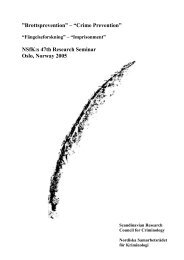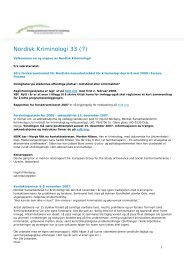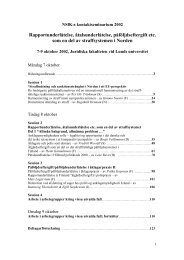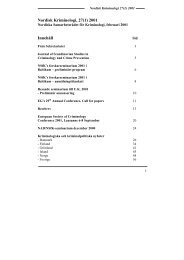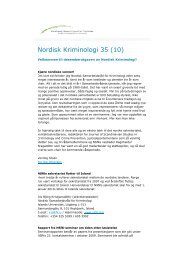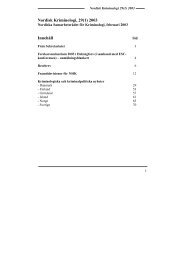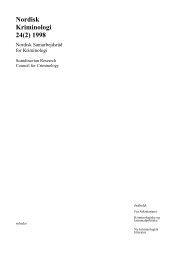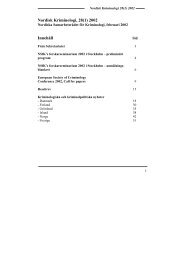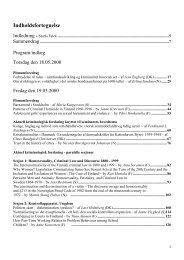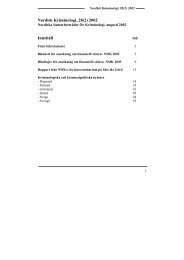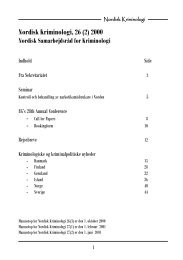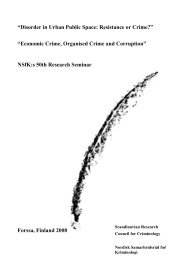Organised Crime & Crime Prevention - what works? - Scandinavian ...
Organised Crime & Crime Prevention - what works? - Scandinavian ...
Organised Crime & Crime Prevention - what works? - Scandinavian ...
Create successful ePaper yourself
Turn your PDF publications into a flip-book with our unique Google optimized e-Paper software.
NSfK’s 40. forskerseminar, Espoo, Finland 1998<br />
Finnish border, seems to be the most alarming. From 1990 to 1995 the murder rate grew from<br />
5,8 to 20 per 100,000 inhabitants. And when one looks at the statistics concerning causes of<br />
death, one may observe that only 60-70 percent of actual murders were ever registered! The<br />
law enforcement officials of St. Petersburg estimate that there are up to 200 leaders of<br />
“organized crime”, and up to 15,000 participants in “criminal organizations” living in the city.<br />
Annually the authorities expose over 500 “criminal organizations” and around 2,000 crimes<br />
and dozens of murders committed in the context of “organized crime”. At the same time, the<br />
Finnish law enforcement officials do not even know how to register such categories.<br />
Confiscations from the criminal groups of St. Petersburg include firearms, narcotics,<br />
explosives and hard currency worth hundreds of thousands of U.S. dollars, and the numbers<br />
are increasing.<br />
Several Russian law enforcement officials, criminologists from the Ministry of the Interior,<br />
academics and reporters share the view that Russia is in a state of criminal chaos,<br />
contaminated and infested with the phenomena that they describe as “organized crime”.<br />
Meanwhile, the interaction between Finland and Russia has grown considerably in the 1990´s.<br />
The flow of people, goods and capital has increased over the 1,300 kilometer border that<br />
Finland, alone in the European Union, shares with the Russian Federation. In St. Petersburg<br />
and its surroundings, only a few hundred kilometres from Helsinki, there are more people<br />
than in the whole of Finland. The number of visits paid by Russian visitors to Finland has<br />
skyrocketed up to one million people annually, which is an exceptional figure for a country of<br />
five million. On their shopping sprees in Finland, the Russian tourists annually spend approximately<br />
600,000 U.S. dollars. Annually over 300,000 Russian automobiles cross the border<br />
and hit the Finnish roads. The volume of Finnish-Russian trade has grown considerably over<br />
the past few years, exceeding the massive Soviet-Finnish clearing trade. A majority of the<br />
75,000 foreigners living in Finland originate from the former Soviet Union, and their number<br />
is expected to double over the next 10-15 years. Over 20,000 people living in Finland report<br />
that they speak Russian as their mother tongue.<br />
This economic, cultural and social interaction between Russia and Finland has reached levels<br />
unknown in the history of the two countries.<br />
Knowing the dangerous dimensions of crime in Russia, one may well ask about the criminal<br />
consequences of the interaction between Finland and Russia. What kind of evidence does the<br />
Finnish law enforcement have about crime originating in Russia? What kind of quantitative<br />
and qualitative changes has the Finnish crime situation undergone? How is “Russian crime”<br />
discussed in Finland? How is Finnish law enforcement reacting to crime originating in<br />
Russia? What kind of security agenda has been established for combating this crime?<br />
Rather paradoxically, the evidence produced by Finnish law enforcement does not reveal any<br />
considerable quantitative growth or qualitative change, which could be attributed to Russian<br />
influences, in the Finnish crime situation.<br />
In spite of the annual volume of one million visitors from Russia, the statistics of crime and<br />
conviction show that annually only about one percent of suspects and convicts are citizens of<br />
Russia. The majority of the crimes committed by Russians are traffic offences and petty<br />
larcenies, which applies to the general population equally. For instance, in 1996 only three<br />
Russians and four Swedes were suspected of murder in Finland, while the number of Finnish<br />
suspects was over 500.<br />
36



